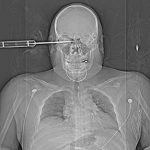There is a lot of angst out there among trauma professionals when it comes to clearing the cervical spine and possible distracting injuries. I’ve written about this before, and the most important technique I use is to try to see if the patient is aware of pain in areas distant from the suspected distraction.
A recent prospective study looked at injury patterns and c-spine clearance in over 9,000 trauma patients at a single Level I trauma center. Of those, 101 were evaluable (not intoxicated, no head injury) and actually had a cervical fracture. 96% of them were symptomatic, despite the majority having what would normally be considered a distracting injury (87%). Of the 4 who did not have pain or tenderness on examination of the neck, every one of them had a distraction.
There was a pattern as to which “distracting” injuries were really a distraction. All four of the asymptomatic patients had bruising or tenderness to the upper anterior chest, which diverted their attention away from their neck. Other injuries caused pain in some of these patients, but it was outweighed by the chest wall pain.
Bottom line: Distracting injury is currently defined too liberally, which results in lots of patients getting lots of unneeded cervical spine imaging. Although this study is small, it adds one more piece of information to the c-spine clearance puzzle. I personally will add this to my current practice and clear the cervical spine if:
- The patient is aware of multiple sources of pain
- Subjective pain scale overall is less than 6 (otherwise provide better pain control!)
- There is no pain/tenderness/injury to the upper chest
Related posts:
Reference: The presence of nonthoracic distracting injuries does not affect the initial clinical examination of the cervical spine in evaluable blunt trauma patients: a prospective observational study. J Trauma 71(3):528-532, 2011.




